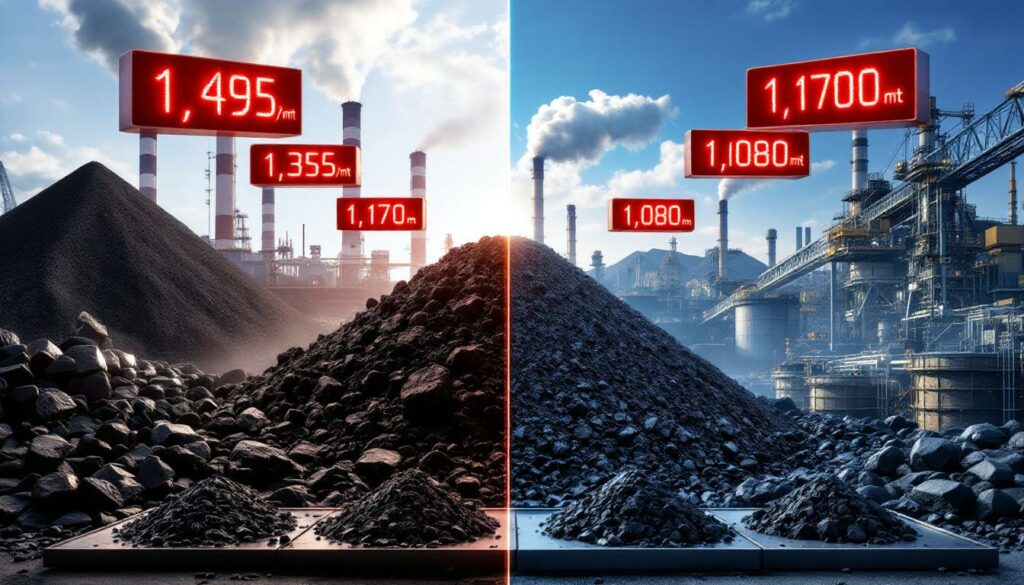How is the Coke Market Performing in 2025?
The coke market has shown remarkable resilience in mid-2025, with prices trending upward across all grades amid supply constraints and steady demand. First-grade metallurgical coke (dry-quenched) currently commands a premium price, averaging 1,495 yuan/mt nationally, while quasi-first-grade dry-quenched coke trades at 1,355 yuan/mt. The wet-quenched varieties fetch lower prices, with first-grade at 1,170 yuan/mt and quasi-first-grade at 1,080 yuan/mt.
Recent price increases have been successfully implemented across major production regions, with market analysts projecting additional rises in the coming week as supply-demand fundamentals continue to favor sellers.
Current Price Trends and Market Dynamics
The price differential between dry-quenched and wet-quenched coke—approximately 325 yuan/mt for first-grade products—reflects significant quality variations and processing technology differences. Dry-quenched coke, which uses inert gas for cooling rather than water, offers superior strength, stability, and lower moisture content, making it particularly valuable for large-scale blast furnace operations.
"The continued price spread between quenching methods demonstrates the steel industry's willingness to pay premiums for superior coke properties, especially when operating high-efficiency furnaces," notes SMM's chief coke market analyst.
Price momentum has remained positive despite challenging economic conditions, driven primarily by:
- Persistently low inventory levels throughout the supply chain
- Active procurement by downstream consumers
- Production curtailments at multiple coke plants
- Strong cost support from raw material inputs
Supply-Side Factors Affecting Coke Markets
Supply constraints have become increasingly prominent in recent weeks, creating a fundamental market tightness that supports the bullish price trend. Several key factors are limiting coke availability:
- Operational losses forcing some producers to reduce output or temporarily idle capacity
- Enhanced environmental protection measures in key production regions, particularly Wuhai
- Low plant utilization rates as producers attempt to balance market supply
- Logistics disruptions affecting timely delivery to end-users
The environmental restrictions in Wuhai deserve particular attention, as authorities have implemented stringent emission controls affecting approximately 30% of regional capacity. This policy enforcement has significantly impacted the supply-demand balance in northern China, creating ripple effects throughout the national market.
Despite active procurement efforts by downstream consumers, inventory levels remain surprisingly low. This paradoxical situation stems from producers' reluctance to operate at full capacity while facing negative margins, creating a supply environment that continues to support price increases.
What's Happening in the Coking Coal Sector?
The coking coal market shows notable regional variations in pricing and availability, with distinct patterns emerging across major production areas. Low-sulfur coking coal—a premium product essential for high-quality coke production—currently trades at 1,320 yuan/mt in Linfen and 1,230 yuan/mt in Tangshan, representing a significant regional differential of 90 yuan/mt.
This price gap primarily reflects transportation cost differentials and regional supply-demand dynamics, with Tangshan's proximity to major steel production hubs providing logistical advantages that translate to lower delivered prices.
Regional Price Variations and Trends
Coking coal prices have shown steady upward momentum following recent coke price increases. This correlation is typical in the industry, as coal represents approximately 70-80% of coke production costs. The market currently exhibits several noteworthy characteristics:
- Pronounced regional differentials reflecting transportation costs and local supply conditions
- Quality premiums for low-sulfur varieties essential for environmental compliance
- Restocking activity driving short-term demand spikes
- Price expectations trending upward among both producers and consumers
Market sentiment has strengthened considerably following successful coke price increases, creating a positive feedback loop that supports coal price appreciation. Traders report increased purchasing activity at mines as downstream consumers seek to secure supplies ahead of anticipated further price increases.
Production and Supply Chain Developments
The coking coal supply chain is currently in transition, with gradual resumed haulage operations following maintenance periods and regional production restrictions. However, this recovery remains uneven:
- Incomplete production recovery at several key mines limiting available supply
- Increased downstream procurement creating demand pressure
- Smooth shipments from active mines meeting immediate market needs
- Selective coal variety shortages creating pronounced price differentials
"Mine production restoration is progressing, but at varying rates depending on local conditions and regulatory requirements," explains an SMM coal market specialist. "This uneven recovery pattern creates opportunities for price premiums on varieties experiencing supply constraints."
Transportation logistics remain generally smooth, though regional bottlenecks occasionally emerge, particularly during peak shipping periods. Rail capacity constraints can temporarily exacerbate regional price differentials, though these effects typically normalize within 7-10 days.
How Are Steel Mills Influencing the Coke and Coal Markets?
Steel producers maintain a powerful influence over the coke and coal markets as the dominant consumers of these essential raw materials. Currently, steel mill profitability remains favorable despite elevated raw material costs, allowing most producers to maintain high operating rates and steady procurement patterns.
This combination of robust profitability and high production levels creates persistent demand for coke and coal, providing a solid foundation for current market dynamics.
Steel Industry Demand Patterns
The steel industry's demand patterns exhibit several key characteristics that directly impact coke and coal markets:
- Rigid coke requirements for blast furnace operations with limited substitution options
- Inventory management strategies balancing cost control and supply security
- Quality specifications that vary based on end-product requirements
- Procurement timing often influenced by price expectations
Some mills have recently requested expedited deliveries due to supply concerns, indicating potential inventory pressures at certain facilities. This urgency partly stems from trader diversion of supplies to higher-margin opportunities, affecting traditional direct-procurement channels.
"The steel industry's procurement behavior reflects a complex balance between immediate operational needs and strategic inventory positioning," notes a senior procurement manager at a major steel producer. "Mills must weigh the risks of potential supply disruptions against the costs of carrying excess inventory in a volatile price environment."
Impact of Steel Production on Raw Material Markets
Steel production levels directly drive coke and coal consumption through well-established technical relationships. Currently, sustained high production rates are maintaining steady demand pressure on raw material markets. Notable dynamics include:
- Operational efficiency improvements marginally reducing consumption ratios at advanced facilities
- Regional variations in procurement strategies based on local supply conditions
- Evolving inventory management practices adapting to market volatility
- Varying price sensitivity depending on steel product profitability
The most efficient mills have achieved modest reductions in coke consumption rates through technologies like pulverized coal injection (PCI) and optimized burden distribution. However, these efficiency gains have been largely offset by increased overall production levels, maintaining strong aggregate demand for coke and coal.
Steel producers focused on high-value products (such as automotive sheet and special bar quality) generally show lower price sensitivity in raw material procurement, prioritizing quality consistency and supply security over cost minimization. The steel market challenges continue to shape this dynamic relationship.
What Are the Key Market Indicators to Watch?
Monitoring specific market indicators provides valuable insights into developing trends and potential price movements in the coke and coal sectors. These indicators encompass both supply-side metrics and demand-side factors that collectively shape market dynamics.
Critical Supply-Demand Metrics
The most informative market indicators currently include:
1. Mine production recovery rates and timelines
- Current status: Gradual but incomplete recovery at key sites
- Significance: Directly impacts raw material availability
- Monitoring approach: Track announced restart schedules against actual production data
2. Coke plant operating rates and capacity utilization
- Current status: Below optimal levels due to margin pressure
- Significance: Determines immediate coke availability
- Monitoring approach: Weekly provincial production statistics and inventory reports
3. Steel mill inventory levels and procurement patterns
- Current status: Generally low inventories with active procurement
- Significance: Indicates immediate demand pressure
- Monitoring approach: Industry association surveys and portside inventory monitoring
4. Regional environmental policy implementation intensity
- Current status: Heightened enforcement in Wuhai region
- Significance: Can rapidly change supply conditions
- Monitoring approach: Local government announcements and compliance reports
5. Trader positioning and inventory accumulation strategies
- Current status: Selective accumulation of premium materials
- Significance: Provides early signals of market direction
- Monitoring approach: Trader surveys and portside inventory differentiated by grade
Price Movement Catalysts
Several specific catalysts have historically triggered significant price movements in coke and coal market review:
| Catalyst | Current Status | Potential Impact |
|---|---|---|
| Environmental inspections | Active in Wuhai region | Supply restrictions supporting prices |
| Production cost structures | Rising energy and labor costs | Establishing price floors |
| Seasonal demand fluctuations | Entering typical summer slowdown | Potentially moderating demand |
| Import-export dynamics | Limited import availability | Supporting domestic prices |
| Transportation constraints | Generally smooth with isolated bottlenecks | Regional price differentials |
"Environmental policy enforcement remains the most potent near-term catalyst for supply disruptions," observes an SMM market analyst. "The timing and intensity of inspection campaigns can rapidly shift market balances, particularly in concentrated production regions."
Production cost structures have established effective price floors, with most producers operating near breakeven levels. Any sustained trading below current price levels would likely trigger additional production curtailments, tightening supply and supporting a price recovery.
How Might the Market Develop in Coming Weeks?
Market projections indicate continued price support in the immediate term, with potential for additional increases as current supply-demand fundamentals persist. Both industry participants and market analysts anticipate stable to moderately strengthening conditions through the remainder of the month.
Short-Term Outlook and Projections
The immediate outlook for coke and coal markets appears supportive, with several factors combining to maintain upward price pressure:
- Expected continuation of price support due to structural supply tightness
- Potential for additional price increase announcements in the coming week
- Persistent supply constraints while production restrictions continue
- Sustained demand from steel sector maintaining market balance
- Cost pressures continuing to influence producer pricing strategies
Recent price increases have been successfully implemented without significant demand destruction, suggesting further upside potential as the market adjusts to supply limitations. Most analysts project an additional increase of 30-50 yuan/mt for first-grade coke in the coming week, with corresponding adjustments for other grades.
"The market fundamentals currently favor sellers, with limited inventory throughout the supply chain and steady end-user demand," notes a veteran industry observer. "Barring unexpected macroeconomic developments, this supportive environment should persist through month-end."
Factors That Could Alter Market Trajectory
Despite the generally positive short-term outlook, several factors could potentially disrupt current market trends:
-
Changes in environmental policy enforcement intensity
- Relaxation could increase supply availability
- Intensification could further restrict production
-
Shifts in steel production profitability
- Margin compression could reduce raw material demand
- Improved margins could accelerate procurement
-
Weather-related disruptions
- Heavy rainfall affecting mining operations
- Extreme heat impacting transportation logistics
-
New capacity additions or restarts
- Accelerated production recovery at idled facilities
- Commissioning of previously delayed projects
-
Macroeconomic policy adjustments
- Changes in industrial production targets
- Credit availability for industrial enterprises
Market participants should monitor these potential catalysts closely, as they could trigger rapid shifts in the current supply-demand balance. The environmental policy enforcement schedule represents perhaps the most significant near-term variable, with inspection announcements often preceding noticeable market movements. Additionally, the iron ore price trends and any iron ore surplus impact could affect the broader market dynamics.
How Are Different Market Segments Performing?
The coke and coal markets exhibit notable segmentation across product types, quality specifications, and geographic regions. Understanding these differences provides valuable insights into market dynamics and potential opportunities.
Metallurgical Coal Market Segment Analysis
The metallurgical coal market shows distinct performance patterns across different segments:
By Coal Type:
- Premium hard coking coal: Commanding the highest prices with limited availability
- Standard coking coal: Adequate supply meeting routine demand
- Semi-soft coking coal: Price-sensitive segment with substitution potential
- PCI coal: Strong demand for blast furnace injection applications
By Sulfur Content:
- Low-sulfur varieties (≤0.6%): Premium pricing reflects environmental compliance value
- Medium-sulfur varieties (0.6-1.0%): Standard pricing with good availability
- High-sulfur varieties (≥1.0%): Discount pricing requiring blending or treatment
By Geographic Region:
- Shanxi production: Premium pricing for quality consistency
- Inner Mongolia production: Mid-tier pricing with growing quality reputation
- Imported materials: Limited availability with price premiums for Australian varieties
Production recovery patterns vary significantly by coal type and region, with premium varieties experiencing stronger price support due to their limited substitutability in high-quality coke production. Regional supply-demand balances also show substantial geographic variations, with transportation costs significantly impacting delivered pricing. Furthermore, ongoing trade war impact strategies continue to influence market dynamics in complex ways.
Coke Market Segmentation Trends
The coke and coal market review demonstrates clear segmentation across several dimensions:
| Segment Factor | High-Tier Market | Mid-Tier Market | Economy Tier |
|---|---|---|---|
| Quenching Method | Dry-quenched | Hybrid methods | Wet-quenched |
| CSR Rating | ≥65% | 60-65% | <60% |
| Ash Content | <12% | 12-13% | >13% |
| Typical Price (yuan/mt) | 1,400-1,500 | 1,200-1,400 | 1,000-1,200 |
| Primary Customers | Large integrated mills | Mid-sized mills | Small mills & foundries |
Price differentials between dry-quenched and wet-quenched products remain substantial, reflecting both quality differences and production cost disparities. The current spread of approximately 325 yuan/mt for first-grade materials represents a near-historical high, indicating strong valuation of quality characteristics.
Quality grade premiums directly reflect downstream requirements, with the most advanced blast furnaces requiring superior coke properties to maintain operational efficiency and product quality. This technical relationship creates persistent demand for premium coke despite its higher cost.
Regional production constraints, particularly environmental compliance requirements, have created geographic price variations beyond normal transportation cost differentials. Areas with stricter enforcement typically command higher prices due to compliance-related production costs and supply limitations. For the latest detailed analysis on coking coal trends, you can check The Coal Hub's latest market outlook report and the SX Coal Market Analysis for comprehensive industry insights.
Disclaimer: This market analysis contains forward-looking statements based on current information. Actual market developments may differ due to unforeseen events, policy changes, or economic shifts. Readers should conduct their own research before making business or investment decisions based on this information.
Want to Invest in the Next Major Mineral Discovery?
Stay ahead of the market with Discovery Alert's proprietary Discovery IQ model, which instantly notifies investors of significant ASX mineral discoveries and transforms complex data into actionable insights. Understand why historic discoveries can generate substantial returns by visiting Discovery Alert's dedicated discoveries page.




